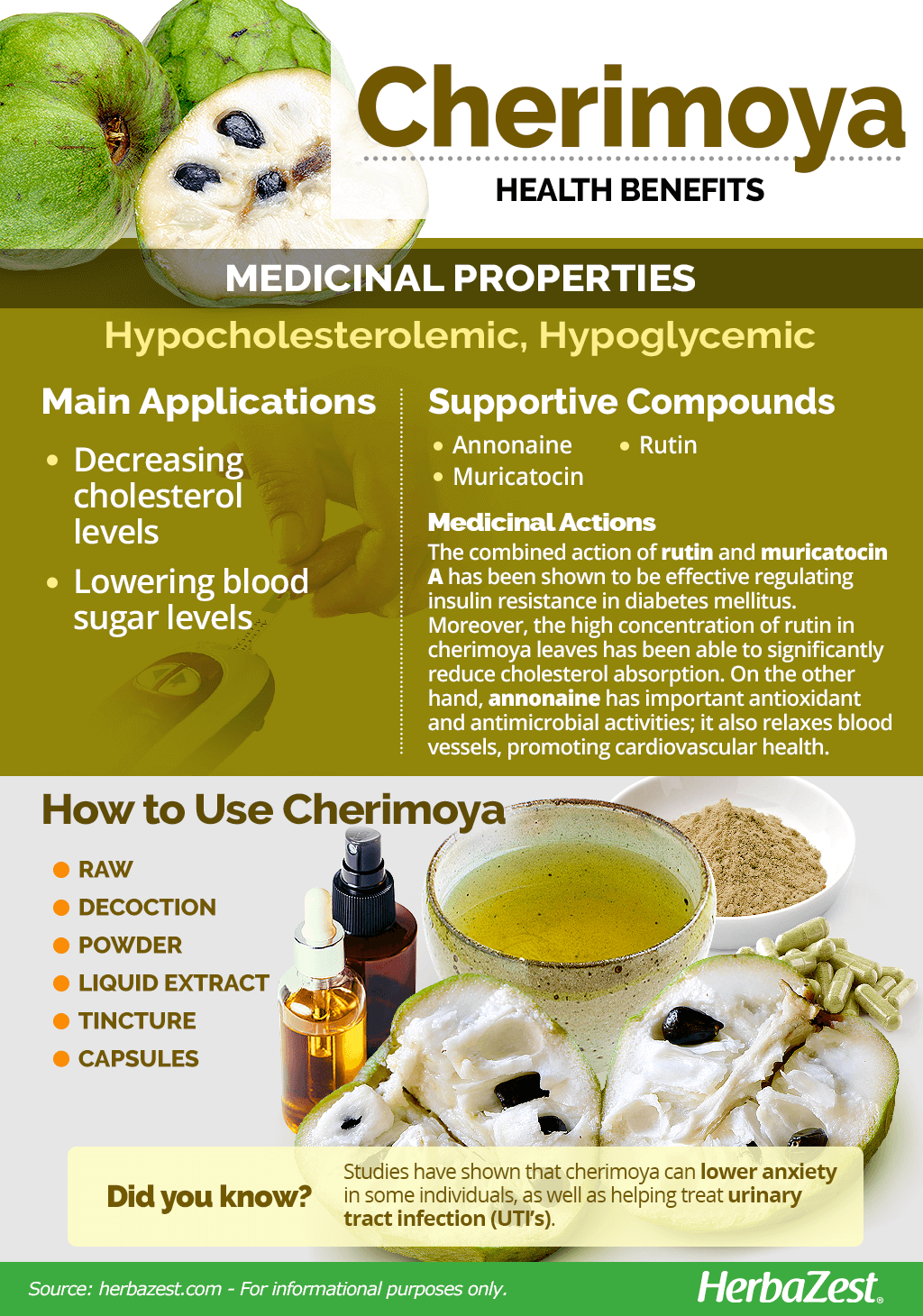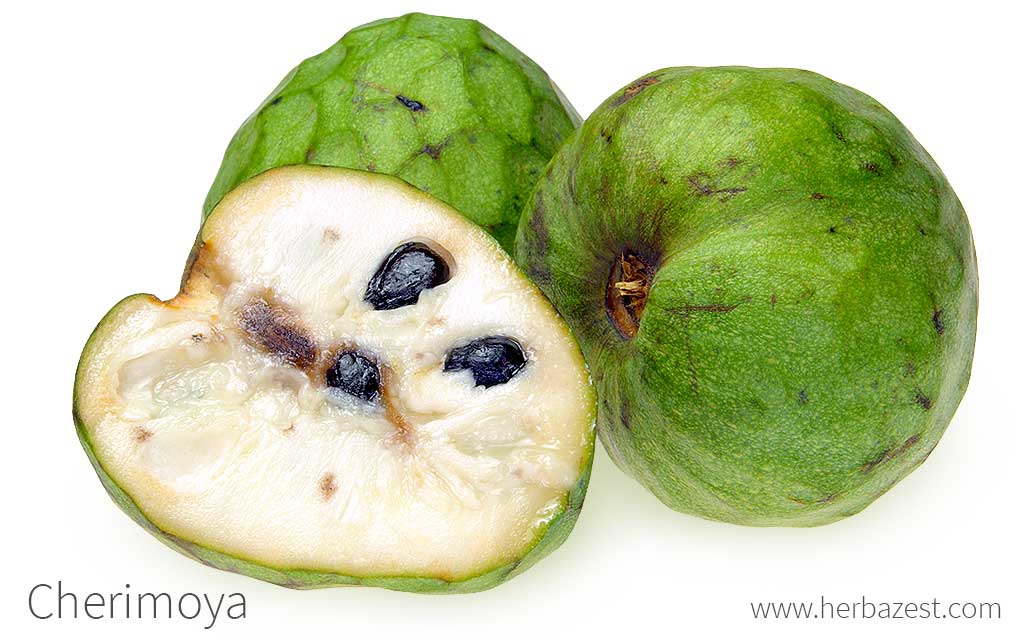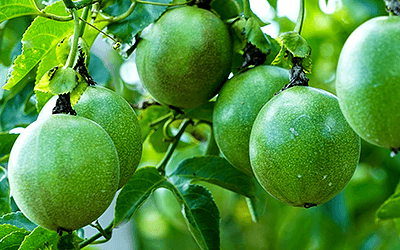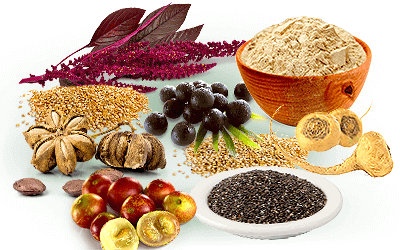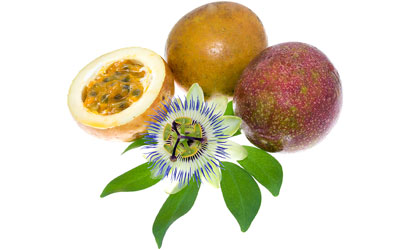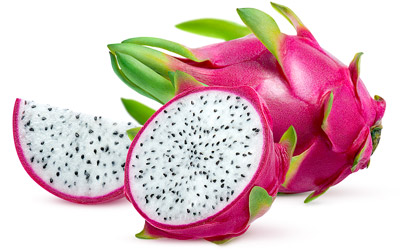Cherimoya is a sweet fruit that is packed with nutrients and is consumed around the world. However, there is much more to cherimoya than its pleasant flavor: traditionally, cherimoya seeds and skin have been used to treat lice or as a remedy for pneumonia and respiratory diseases. However, modern research has found great potential in the antioxidant and hypocholesterolemic properties of this delicious fruit.
Cherimoya Medicinal Properties
- Medicinal action Hypocholesterolemic, Hypoglycemic
- Key constituents Annonaine, muricatocin, rutin
- Ways to use Decoctions, Food, Juiced, Tincture
- Medicinal rating (2) Minorly useful plant
- Safety ranking Safe
Health Benefits of Cherimoya
Although reliable, double-blind, placebo-controlled research on the medicinal uses of cherimoya is still lacking, the plant has been used with the following purposes as part of traditional practices, mostly limited to its native regions:
Decreasing cholesterol levels. Like many fruits, cherimoya can help to lower unhealthy cholesterol levels.
Lowering blood sugar levels. Cherimoya is beneficial for managing blood sugar levels, especially for individuals who need to lower their blood sugar levels.
In addition, cherimoya can help fight other conditions, such as:
Treating lice infestations and other parasitic skin ailments. Traditionally, the seeds of cherimoya have been peeled, toasted, and then made into a powder. When this is mixed with grease, it is used to treat lice. The traditional treatment for lice is also used on other parasitic skin ailments.
Reducing anxiety. Studies have shown that eating cherimoya can lower anxiety levels in some individuals.
Healing pneumonia. An extract from the skin of the fruit is used to treat pneumonia.
Combating bacterial infections. Cherimoya can treat bacterial infections, such as urinary tract infections (UTIs).
How It Works
Annonaine has important antioxidant and antimicrobial activities, it also has been proved to relax blood vessels, promoting cardiovascular health.1 Both the leaves and the pulp of cherimoya contain a large number of beneficial phytochemicals, such as polyphenols, tocopherols, phytosterol, diterpernes, and triterpenes. However, a flavonoid called rutin, along with muricatocin, an annonaceous acetogenin, are thought to be responsible for most of the medicinal properties of cherimoya.
Rutin and muricatocin A have been shown effective to regulate the expression of FOXO1, a protein associated to insulin resistance in diabetes mellitus.2 Moreover, the high concentration of rutin in cherimoya leaves has been able to significantly reduce cholesterol absorption by inhibiting HMG-CoA reductase, which is an enzyme involved in lipid metabolism.3
Avocado and olive also possess hypocholesterolemic properties, while carambola and graviola can be used as alternative sources for hypoglycemic benefits as well.
Cherimoya Side Effects
Cherimoya is likely safe for people when eaten as a food. However, the seeds of cherimoya can be poisonous, and side effects include dilated pupils, sensitivity to light, nausea, dry mouth, a burning sensation in the throat, flatulence, and vomiting.
Cautions
Individuals who are diabetic or have other conditions that require them to closely monitor their blood sugar levels should exercise caution when eating cherimoya since it can lower blood sugar levels.
Women who are pregnant or breastfeeding should consult a physician before consuming cherimoya.
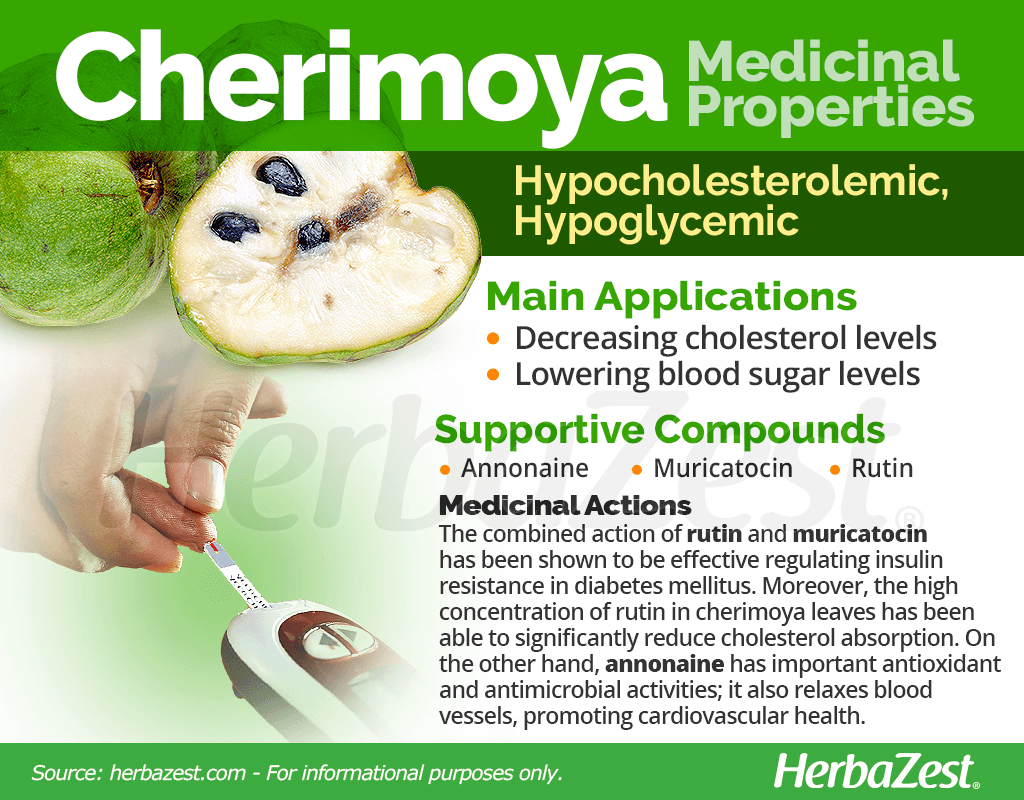
Cherimoya Nutrition
The most abundant nutrient in cherimoya is vitamin B6 (pyridoxine),which contributes to enhance mood and regulates the sleep cycles, acting as a mild antidepressant and anxiolytic agent. Cherimoya is also agood source of two important compounds, vitamin C (ascorbic acid), great for preventing common diseases, helping iron absorption, and supporting skin health; and vitamin B2 (riboflavin), which is an essential human nutrient, necessary for cellular functions and energy production.
The cherimoya fruit also provides adequate amounts of vitamins B1 (thiamin), B5 (pantothenic acid), and B9 (folate), as well as the minerals copper and potassium, along with small amounts of other important nutrients, such as B3 (niacin), vitamin E (alpha-tocopherol), magnesium, manganese, iron, phosphorus, zinc, and calcium.
100 grams of cherimoya fruit provide 75 calories, as well as 12% of the daily value for dietary fiber.

How to Consume Cherimoya
- Edible parts Fruit
- Edible uses Flavoring, Beverage, Dairy substitute, Sweetener
- Taste Sweet
While it is often used for culinary purposes, the most effective way of obtaining cherimoya's health benefits is in its medicinal forms of consumption, where the properties are more concentrated.
Natural Forms
Raw. Fresh cherimoya is not only delicious, but it also provides significant health benefits, including lowering blood sugar and cholesterol levels.
Decoctions. Cherimoya skin decoctions help lower blood sugar levels and treat anxiety, as well as relieve pneumonia.
Powder. Once the pulp of cherimoya is dried and finely ground, it can be added to smoothies an juices for increased nutritional value. In powder form, cherimoya also helps lower bad cholesterol and treats urinary tract infections (UTIs).
Herbal Remedies & Supplements
Liquid extracts. In this form, cherimoya liquid extracts treat anxiety and treat bacterial infections.
Tinctures. In tincture form, cherimoya can help treat pneumonia, as well as bacterial infections due to its antimicrobial properties.
Capsules. In supplemental form, cherimoya's contributes to regulate blood sugar levels.
CHERIMOYA IS COMMONLY PROCESSED INTO NECTARS, JUICE, WINE, AND ICE CREAM.
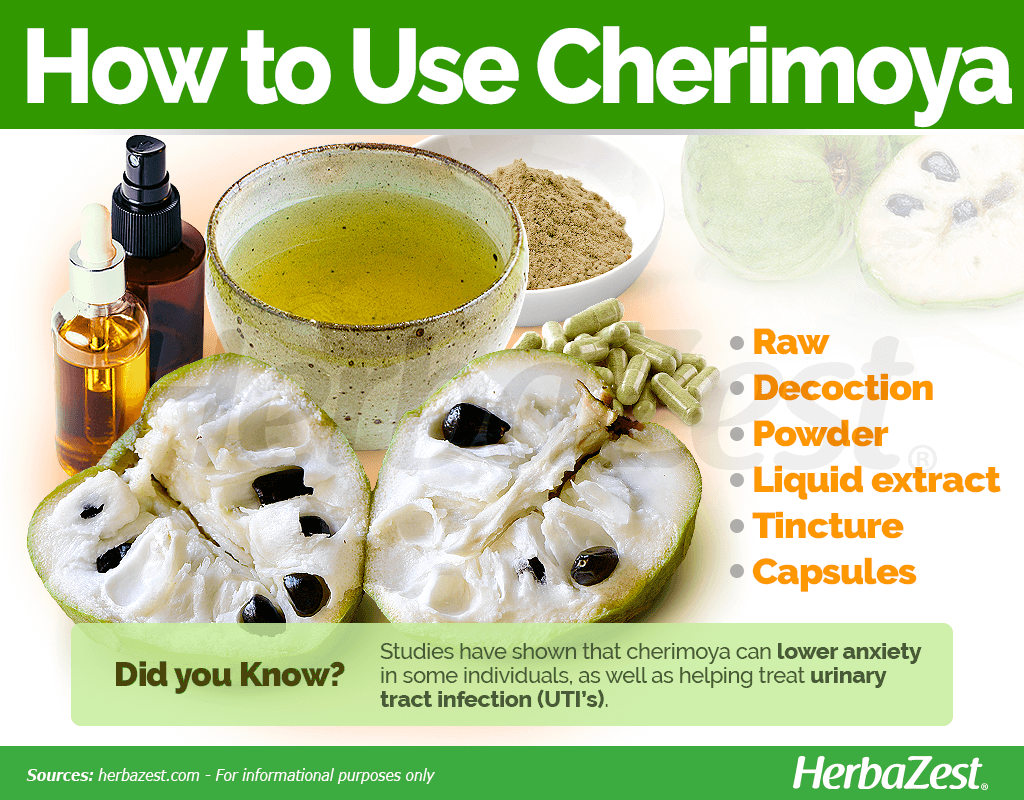
Buying
- Where to buy Supermarkets, Farmers' markets
Natural Forms
Raw cherimoya is the most popular form of consumption, and the fruit can be found at most grocery stores in the produce section year round.
Cherimoya is also commonly processed into nectars, juice, wine, and ice cream, which are also typically available at most supermarkets and grocery stores.
Herbal Remedies & Supplements
Cherimoya supplements are widely available in online retailers and at some nutrition shops.
Growing
- Life cycle Perennial
- Harvested parts Fruit
- Light requirements Full sun
- Soil Loamy sand
- Soil pH 6.1 – 6.5 (Slightly acidic), 6.6 – 7.3 (Neutral), 7.4 – 7.8 (Slightly alkaline)
- Growing habitat Subtropical regions
- Plant spacing average 7 m (22.97 ft)
- Propagation techniques Cuttings
- Potential diseases Phytophthora spp., Root rot
Cherimoya is a deciduous tree that typically grows to around 30 feet (9 m) in height. This subtropical species grows best in warm, humid conditions. Cherimoya trees begin bearing fruit three to four years after being planted, so those who wish to grow them will reap the benefits relatively quickly in comparison to other types of fruit. For additional tips for how to successfully grow a cherimoya tree, follow the guidelines below:
Growing Guidelines
Cherimoya grows best in neutral soils (pH level of 6.5 - 7.5), and prefers low temperature oscillations throughout the year.
Cherimoya trees should be grown in a sunny are with well-drained and loose soil, with a fairly steady water supply
If they are grown near a coastal area, cherimoya trees will need to be protected from the wind, since high winds can damage them relatively easily
They are best propagated through grafting, as this allows a more accurate control of the quality of future fruit, and the trees should ideally be kept 22 feet (7 m) apart from each other.
Fertilizing trees twice a year is recommended for optimal growth
Pollination will need to be done artificially, as natural pollinators are scarce, and male and female flowers rarely mature at the same time. Formation pruning can help speed up this process.
Cherimoya is prone to root rot and fruit fly infestations.
Additional Information
Plant Biology
The cherimoya tree is a fairly dense, fast-growing deciduous tree that can grow up to 30 feet (9 m) in height. The tree produces light-green flowers and heart-shaped, medium-sized fruit with dark green, scaly skin, and white, creamy flesh.
Classification
Cherimoya, or Annona cherimola, is part of the Annonaceae family, with approximately 2,500 other species across 130 genera. The family includes mainly tropical plants, like graviola (Annona muricata), sugar apple (Annona squamosa), and ylang ylang (Cananga odorata), with few species, such as paw paw (Asimina triloba), found in temperate regions.
The name of the genus, Annona, is the Latin word for "year's harvest."
Varieties and Cultivars of Cherimoya
Although no subspecies exist, cherimoya cultivars has been developed through selective breeding in order to maximize yields, hardiness, or specific fruit qualities.
In Peru, cherimoyas are commercially classed according to degree of surface irregularity, as: 'Lisa' (almost smooth), 'Impresa' (with "fingerprint" depressions), 'Umbonada', (rounded protrusions), 'Papilonado', or 'Tetilado' (fleshy, nipple-like protrusions), 'Tuberculada' (conical protrusions having wartlike tips).
'Ott' cherimoyas are popular in the United States because of their relative hardiness and ability to survive inland, alongside the 'Deliciosa' cultivar - although the latter can achieve a higher market price because of its preferred flavor.
On the other hand, cultivars such as 'Spain' or 'Ryerson' are sweeter and banana-like in flavor, although they require higher temperatures and coastal climates to grow. Other major cultivars include 'Bays', 'Chaffey', 'Pierce', 'White', and 'Bayott' cherimoyas.
Historical Information
The first depictions of cherimoya date back to 700 BCE, on pottery vases belonging to pre-Incan cultures, where it seems to have been regarded as sacred. Cherimoya was a highly valued fruit among the Incas, who used to refer to it as the "pearl of the Andes." The Spanish brought the fruit to different parts of the world, especially around the Mediterranean.
Classic American author Mark Twain was a fan of cherimoya and considered it “the most delicious fruit known to men.”
Economic Data
Cherimoya's popularity has spiked in recent years, as it is considered an "exotic" fruit in many countries. In North America and Japan, cherimoya costs more than almost any other market fruit. Advanced transportation methods and cherimoya hybrids have recently opened up the international trade industry for the fruit. Spain, Peru, and Chile are among of the top cherimoya producers.
Other Uses of Cherimoya
Skin care. Because of its high vitamin C content, cherimoya fruits are highly effective for skin care. It is used for reducing the appearance of wrinkles and fine lines, as well as combating free radicals.
Hair care. Cherimoya keeps helps maintain hair health and prevents damage from free radicals.
Sources
- Fruits of Warm Climates, Cherimoya
- Lost Crops of the Incas, pp. 228-239
- University of California, UC Cooperative Extension: Cherimoya
- FAOSTAT, Promoting cultivation of cherimoya in Latin America
- Pharmacognosy Research, Antihyperglycemic Activity of the Leaves from Annona cherimola Miller and Rutin on Alloxan-induced Diabetic Rats, 2017
- Phytochemistry, Four alkaloids from Annona cherimola, 2001
Footnotes
- Molecules. (2013). The Pharmacological Activities of (−)-Anonaine. Retrieved April 4, 2023, from: https://www.ncbi.nlm.nih.gov/pmc/articles/PMC6270643/
- In Silico Pharmacology. (2017). Revealing the potency of Annona muricata leaves extract as FOXO1 inhibitor for diabetes mellitus treatment through computational study. Retrieved April 4, 2023, from: https://pubmed.ncbi.nlm.nih.gov/28653156/
- Journal of Ethnopharmacology. (2013). Evaluation of cholesterol absorption and biosynthesis by decoctions of Annona cherimola leaves. Retrieved April 4, 2023, from: https://www.sciencedirect.com/science/article/abs/pii/S0378874113006764
